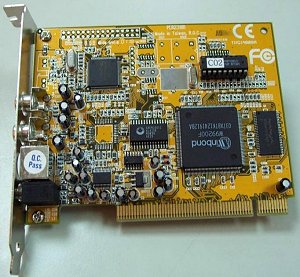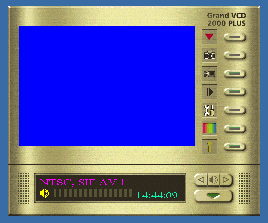PV-231 real-time VCD PCI video/audio capture card
The Provideo PV-231 ( pv231 ) is a simple video capture card for MPEG-1 encoding that totally ignores Macrovision and other such anti-copy technologies. This is a legacy card that, in its day, was a good last resort for capturing video for the creation of VCD (Video CD) media.
Credit to the author of this information: Steve Kittelsen. His site at the address http://steve.kittelsen.com/pv231/ is no longer available. Here is an incomplete archived copy.
The PV231 capture card is a very good quality video capture card that uses the latest compression chip from Winbond. It is also used in the Terrapin VCD recorders. The PV233 is basically the same card, but it has a TV tuner as well. With some small changes to the registry (GOP settings) the card does an excellent job at capturing real-time VCD quality audio and video. The "old" way of making a VCD is time consuming, and often require lots of hard drive space and CPU power. This card can work on a regular PC without a large hard drive and powerful CPU. The card is best suited for video tape to VCD transfers, where not much editing is needed, but where you simply move video from one medium to another. With the addition of a mpeg editor, you can also trim your cuts. In general, it's hard to edit VCD compliant files, so a good editor is needed. The files generated by the PV231 are directly burnable to CD-R(W) without any processing. Also, since the audio is processed by the card and its software, there is no problem with audio/video sync. So far, this is the best quality real-time VCD capture card I have found. Still, I have to say that you can NOT make VCD captures without any blocks in high motion video, that is just not possible at the low bit rate of 1.15Mb/sec.
Below are some screen captures of a static test image. First, the uncompressed original PC image, next an uncompressed AVI capture, and then last, a capture done by the PV231. All captures are done at 352x240, which is considered to be close to VHS quality video, as far as static resolution goes. There are no measurements for motion compression artifacts.
Pros:
* Real-time fully VCD compliant captures, no time wasted on software conversion and AVI captures, demuxing-muxing * Good VCD quality video (Winbond compression chip) * Hardware video noise reduction and field interpolation * 2x Composite and 1x S-Video inputs * NTSC, PAL, and SECAM video capture support * Captures Macrovision video just fine. * No problem with audio/video sync (audio input on the card) * Card can be used on a low powered PC * Very simple capture software * Preview of encoded video during capture * To make a high quality capture "without" any blocks, turn off VCD compliancy and set bit rate to 2400 or higher * Can record I-frames only for easy editing at bit rates up to 6Mb/sec * Drivers and capture applications are compatible with other cards using the Winbond W99200F chip * Stable card and software * Easy to change registry * Cheap capture card ($80)
Cons:
* Missing features in the capture software (has to be set via the registry) * Default factory settings gives poor video (lots of blocks) * No video clip trim feature in the capture software * No audio record level control (auto) * No video histogram for setting video levels * No AVI capture (I-frame only mpeg-1 capture up to 6Mb/sec is possible) * Vertical stripes in bright colors using the S-Video input (NTSC) * No support for 48KHz audio sampling for DVD compliancy (must convert the audio in software) * Card captures VCD mpeg-1 size and format only (no SVCD or mpeg-2)
Software:
Grand VCD 2000 Plus (Provideo/3DeMON) capture application that will work with any PV231 capture card. The other capture applications look quite ugly. However, they all have the same features and functions.

